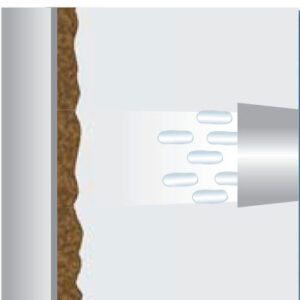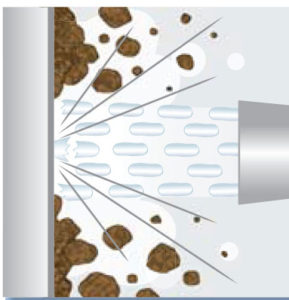
City improvement
City improvement
Target application

Restoration of monuments

Graffiti removing

Restoration of brick surfaces

Cleaning the garbage disposal
Description of usage
The purpose of restoration work is to reconstruct monuments and historical buildings to their original state by removing surface contamination and old coatings. The use of chemicals or abrasive cleaning methods can change the integrity of the surface: chemicals can leach out the structural material, and abrasive cleaning methods can scratch the surface being cleaned. It is also important to use a method that does not contain secondary waste, because in a project such as the control of paint with a lead content of more than 2%, it is extremely important that the disposal method is as safe as possible. The cleaning operator can perform jet cleaning of marble, glass and onyx without the risk of damage to the surfaces. Dry ice cleaning does not leave any secondary waste and provides a multiple reduction in time for post-cleaning. Such cleaning can be used for historical restoration of churches and mosques, marble statues, houses after a fire, removing graffiti and restoring the appearance of brick walls. Also, such cleaning in terms of the rules of the the Ministry of ecology, is ideal for cleaning garbage chutes in residential buildings and removing graffiti in underground passages.
Equipment that can be cleaned by dry ice:
- Monuments
- Museum buildings
- Underground passages
- Pedestrian crossing
- Metro
- Shopping centres
- Business centres
- Administrative building
- Medical centres
- Facades of buildings on busy streets
Cryoblasting advantages

- Reduced downtime for equipment and production
- Increased productivity (reduced cleaning time)
- Effective removal of bacteria (mold, Listeria, Salmonella).
- Degreasing of the surface
- No abrasive that can harm workers and equipment
- Improving the level of occupational safety in the workplace (reducing additional payments for harm and increasing the length of the working week)
- Improving the safety of storage and transportation of cleaning products (reducing surcharges for harm and increasing the length of the working week)
- Reducing the burden on the environment
- Reduction of production losses due to an accident
- Receive discounts on insurance rates in the social insurance Fund against industrial accidents and occupational diseases
- Reducing economic losses due to staff turnover
Cleaning Effect
Mechanical impact of pellets

Pellets, accelerated in the air stream, gaining speed up to 300m/s and hit the dirt removing it
Thermal shock

When in contact with the contamination, the granule transmits a temperature of -79°C, which makes the contamination brittle, easier to break down and peel off
Sharp expansion

Dry ice particles are heated when they hit the pollution, as the kinetic energy of the movement turns into heat, after which the particles instantly turn into CO2 gas, expanding in volume by 700 times. This expansion is similar to a gas wedge that exfoliates the contamination.
Properties of dry ice
DRY ICE DOESN'T MELT
Dry ice is solid carbon dioxide (CO2), which, when heated, passes immediately into the gaseous phase, bypassing
the liquid phase. This process is called sublimation.
LOW TEMPERATURE
Dry ice has an extremely low temperature of -78.5°C. Only the temperature of liquid nitrogen, which is -195.8°C, is lower.
ECOLOGICAL SAFETY
Liquid carbon dioxide used for making dry ice is a by-product of various industries, so no additional greenhouse gases are generated during its production.
Comparison with traditional cleaning methods
Chemical cleaning


Significant time is required for complete or partial disassembly and installation, transportation to the site cleaning, requires the involvement of loading equipment and additional personnel, which leads to increasing the time and complexity of cleaning activities

Chemicals and solvents are dangerous to humans

Chemistry can damage the seals, isolation and others materials

Chemical residues can cause corrosion of metal components of equipment

Use of solvents is flammable and explosive

It is necessary to dispose of chemical waste after cleaning (up to 1 l / sq.metre)
Water jet cleaning


Significant time is required for complete or partial disassembly and installation, transportation to the site cleaning, requires the involvement of loading equipment and additional personnel, which leads to increasing the time and complexity of cleaning activities

It takes time to purge and dry the equipment from the remaining water

Risk of electric shock when working near electrical equipment

The water jet can damage the seals and soft materials of the equipment

Water residues can cause corrosion of metal components of the equipment

It is necessary to clean and dispose of dirty water after cleaning (60-200 l / sq.metre)
Abrasive blasting


Significant time is required for complete or partial disassembly and installation, transportation to the site cleaning, requires the involvement of loading equipment and additional personnel, which leads to increasing the time and complexity of cleaning activities

It takes time to purge and dry the equipment from the remaining abrasive particles

Danger of abrasive settling in in the lungs

Abrasive damages the surface of the equipment

Risk of abrasive particles getting into hard-to-reach areas of the equipment, which may cause it to malfunction

It is necessary to clean and dispose of the abrasive after cleaning (30-100 kg / sq.metre)
Dry ice blasting


Dry ice disappears immediately after cleaning

Dry ice is not a fire hazard

Dry ice is not explosive

Dry ice does not conduct electricity

Quick preparation before cleaning

It is possible to clean without stopping the process line

Minimum post-cleaning time after processing

Degreases and disinfects the surface
Contaminant types VS Air pressure
Light contaminants
- Engine oil deposits
- Fat deposits
- Fresh rust
- Liquid engine oil
- Mold and biodegradation
- Assembly foam
- Porous thermal insulation
- Dust and fluff
- Household dirt
Average contaminants
- Persistent engine oils
- Fresh rust
- Liquid mineral oils
- Lubricating grease
- Fresh glue
- Porous thermal insulation
- Paint on the wood
- Wood cleaning
- Soot
Complicated contaminants
- Bitumen
- Dried glue
- Old rust
- Paint 400 µm
- Carbon

Supersonic nozzles are required


